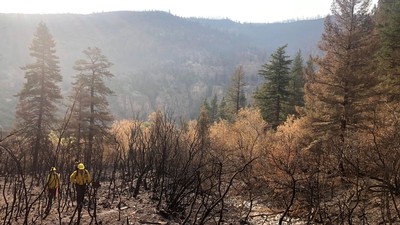Grand Staircase-Escalante Has Rich Bee Diversity say USU Scientists
By Mary-Ann Muffoletto |
A bee seeks pollen from a wildflower in Utah's Grand Staircase-Escalante National Monument. USU researchers say Utah is home to more bee species than most states in the United States. Credit: Joe Wilson.
The state of Utah’s nickname is “The Beehive State,” and the moniker couldn’t be more apt, say Utah State University scientists. One out of every four bee species in the United States is found In Utah and the arid, western state is home to more bee species than most states in the nation. About half of those species dwell within the original boundaries of the newly reduced Grand Staircase-Escalante National Monument.
“The monument is a hotspot of bee diversity,” says USU-Tooele entomologist Joseph Wilson, associate professor in USU’s Department of Biology, who, with scientist and USU alum Olivia Carril, USDA entomologist Terry Griswold and USU emeritus professor James Haefner, reported 660 species now identified in the protected region in the November 7, 2018 issue of PeerJ.
Carril is lead author of the paper, which describes a four-year study, funded by the U.S. Bureau of Land Management and the USDA, in southern Utah’s GSENM.
“We identified almost as many species as are known in the entire eastern United States,” says Carril, a bee researcher based in Santa Fe, NM. “We discovered 49 previously unknown species, as well as 150 ‘morphospecies,’ that is, somewhat unique species that don’t match known species.”
Located in south central Utah, about 250 miles south of Salt Lake City and 200 miles northeast of Las Vegas, Grand Staircase is situated in the arid, sandstone Kaiparowits Plateau and adjacent canyons.
“Many are surprised to learn 87 percent of Utah’s flowering plant species live within the monument’s boundaries,” Carril says. “Which likely contributes to the rich diversity of pollinators.”
Bees found within the monument’s original boundaries, she says, include ground-nesters, cavity and twig-nesters, cleptoparasites, narrow specialists, generalists, solitary and social species. During the team’s study, the bee fauna reached peak diversity each spring, but also experienced a second peak in diversity in late summer, following monsoonal rains.
“It’s an amazing natural laboratory of pollinators, of which we don’t know a lot,” Wilson says. “The large reduction of this protected areas could have implications for future biodiversity.”
A view of Utah's Grand Staircase-Escalante National Monument. USU researchers report nearly half of Utah's bee species dwell within the original boundaries of the newly reduced monument. Credit: Joe Wilson.
WRITER
Mary-Ann Muffoletto
Public Relations Specialist
College of Science
435-797-3517
maryann.muffoletto@usu.edu
CONTACT
Olivia Carril
Alum
Utah State University
sturnella@gmail.com
Joseph S. "Joe" Wilson
Associate Professor, Department of Biology
Utah State University-Tooele
joseph.wilson@usu.edu
TOPICS
Research 911stories Utah 389stories Ecology 176stories Biology 173stories Bees 27storiesComments and questions regarding this article may be directed to the contact person listed on this page.








